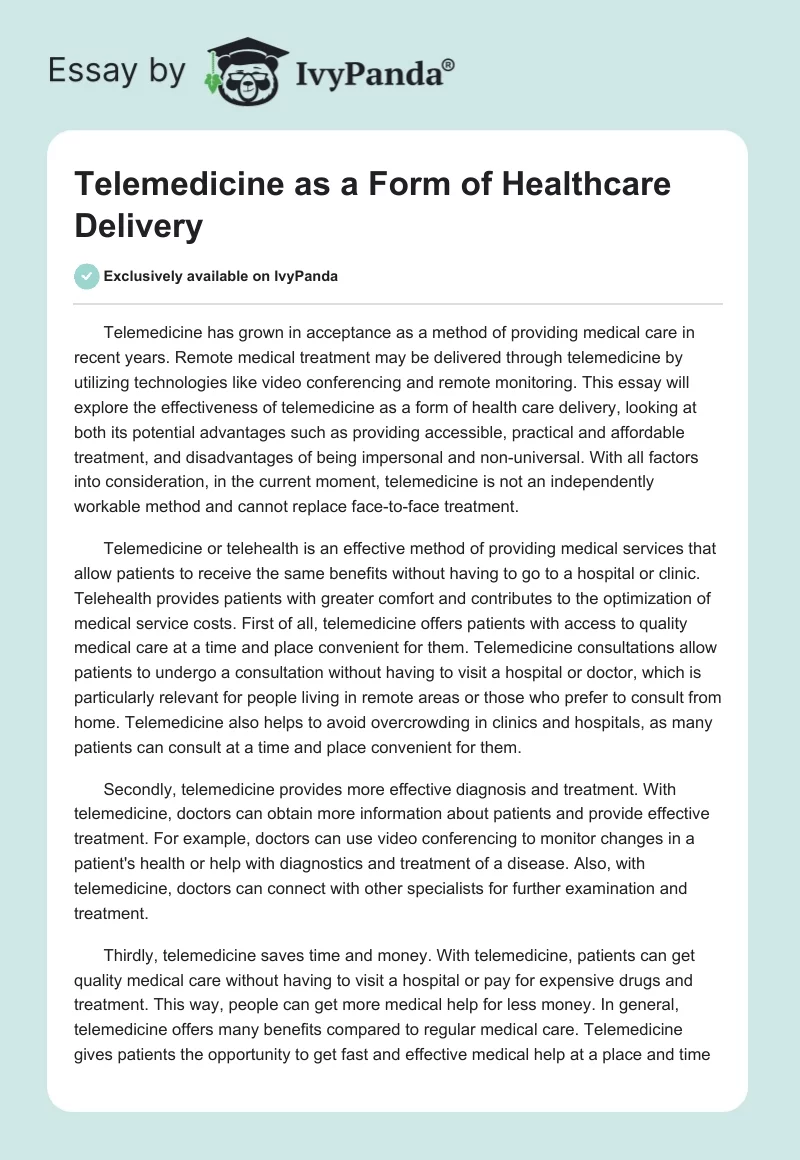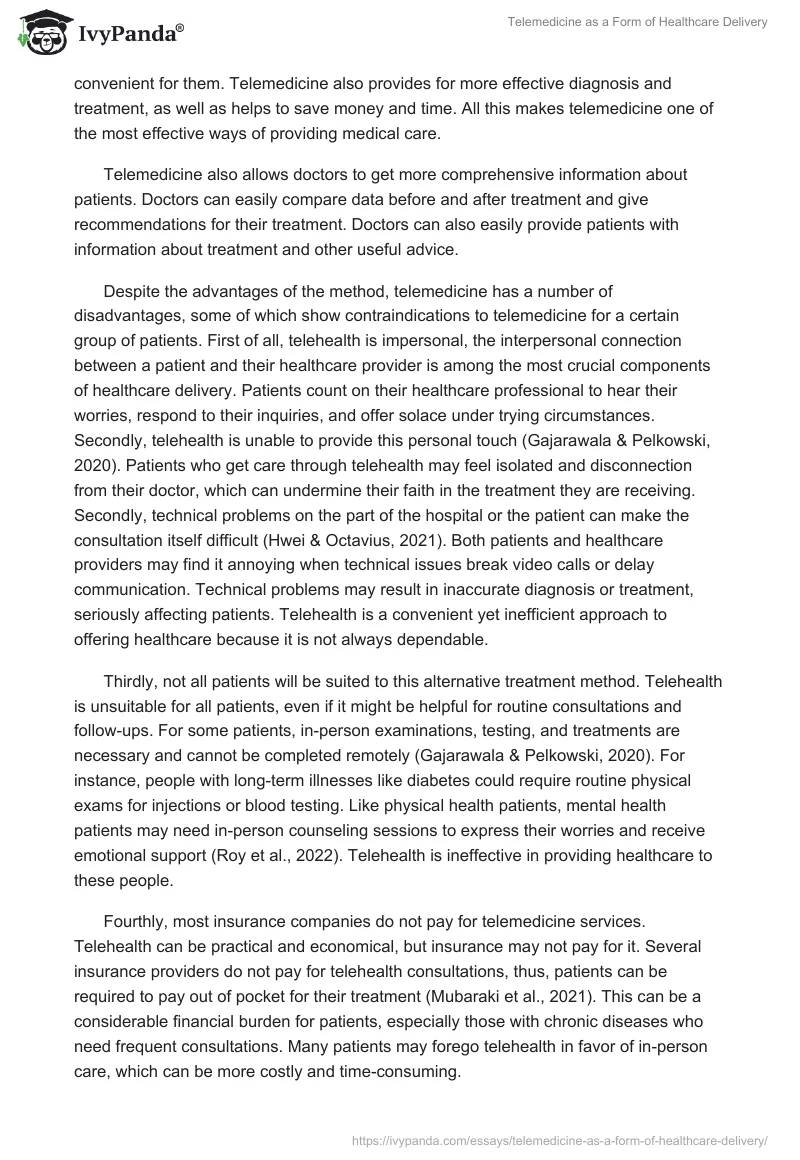Telemedicine has grown in acceptance as a method of providing medical care in recent years. Remote medical treatment may be delivered through telemedicine by utilizing technologies like video conferencing and remote monitoring. This essay will explore the effectiveness of telemedicine as a form of health care delivery, looking at both its potential advantages such as providing accessible, practical and affordable treatment, and disadvantages of being impersonal and non-universal. With all factors into consideration, in the current moment, telemedicine is not an independently workable method and cannot replace face-to-face treatment.
Telemedicine or telehealth is an effective method of providing medical services that allow patients to receive the same benefits without having to go to a hospital or clinic. Telehealth provides patients with greater comfort and contributes to the optimization of medical service costs. First of all, telemedicine offers patients with access to quality medical care at a time and place convenient for them. Telemedicine consultations allow patients to undergo a consultation without having to visit a hospital or doctor, which is particularly relevant for people living in remote areas or those who prefer to consult from home. Telemedicine also helps to avoid overcrowding in clinics and hospitals, as many patients can consult at a time and place convenient for them.
Secondly, telemedicine provides more effective diagnosis and treatment. With telemedicine, doctors can obtain more information about patients and provide effective treatment. For example, doctors can use video conferencing to monitor changes in a patient’s health or help with diagnostics and treatment of a disease. Also, with telemedicine, doctors can connect with other specialists for further examination and treatment.
Thirdly, telemedicine saves time and money. With telemedicine, patients can get quality medical care without having to visit a hospital or pay for expensive drugs and treatment. This way, people can get more medical help for less money. In general, telemedicine offers many benefits compared to regular medical care. Telemedicine gives patients the opportunity to get fast and effective medical help at a place and time convenient for them. Telemedicine also provides for more effective diagnosis and treatment, as well as helps to save money and time. All this makes telemedicine one of the most effective ways of providing medical care.
Telemedicine also allows doctors to get more comprehensive information about patients. Doctors can easily compare data before and after treatment and give recommendations for their treatment. Doctors can also easily provide patients with information about treatment and other useful advice.
Despite the advantages of the method, telemedicine has a number of disadvantages, some of which show contraindications to telemedicine for a certain group of patients. First of all, telehealth is impersonal, the interpersonal connection between a patient and their healthcare provider is among the most crucial components of healthcare delivery. Patients count on their healthcare professional to hear their worries, respond to their inquiries, and offer solace under trying circumstances. Secondly, telehealth is unable to provide this personal touch (Gajarawala & Pelkowski, 2020). Patients who get care through telehealth may feel isolated and disconnection from their doctor, which can undermine their faith in the treatment they are receiving. Secondly, technical problems on the part of the hospital or the patient can make the consultation itself difficult (Hwei & Octavius, 2021). Both patients and healthcare providers may find it annoying when technical issues break video calls or delay communication. Technical problems may result in inaccurate diagnosis or treatment, seriously affecting patients. Telehealth is a convenient yet inefficient approach to offering healthcare because it is not always dependable.
Thirdly, not all patients will be suited to this alternative treatment method. Telehealth is unsuitable for all patients, even if it might be helpful for routine consultations and follow-ups. For some patients, in-person examinations, testing, and treatments are necessary and cannot be completed remotely (Gajarawala & Pelkowski, 2020). For instance, people with long-term illnesses like diabetes could require routine physical exams for injections or blood testing. Like physical health patients, mental health patients may need in-person counseling sessions to express their worries and receive emotional support (Roy et al., 2022). Telehealth is ineffective in providing healthcare to these people.
Fourthly, most insurance companies do not pay for telemedicine services. Telehealth can be practical and economical, but insurance may not pay for it. Several insurance providers do not pay for telehealth consultations, thus, patients can be required to pay out of pocket for their treatment (Mubaraki et al., 2021). This can be a considerable financial burden for patients, especially those with chronic diseases who need frequent consultations. Many patients may forego telehealth in favor of in-person care, which can be more costly and time-consuming.
Lastly, not all healthcare demands may be met via telehealth. Patients frequently have various healthcare needs that telemedicine cannot meet because healthcare is complex. Patients can, for instance, require access to experts, diagnostic procedures, and emergency treatment, none of which can be offered through telemedicine (Mubaraki et al., 2021). In these circumstances, patients need in-person treatment, which can be costly and time-consuming. Telehealth could be a helpful addition to how healthcare is provided, but it cannot replace the whole spectrum of medical treatments that patients require.
In conclusion, telemedicine is not a successful way to offer healthcare. Although telehealth has numerous benefits, it is inappropriate for all individuals or healthcare requirements. Telehealth is impersonal, unpredictable, and not always covered by insurance. It also falls short of meeting all medical needs. Telehealth is a beneficial supplement to in-person care, but it cannot take its place of it. As healthcare practitioners, we must keep researching new technology and healthcare delivery strategies while simultaneously acknowledging the drawbacks of telehealth and the value of face-to-face care.
References
Gajarawala, S., & Pelkowski, J. (2020). Telehealth benefits and barriers. The Journal for Nurse Practitioners, 17(2), 218–221. Web.
Hwei, L. R. Y., & Octavius, G. S. (2021). Potential advantages and disadvantages of telemedicine: A literature review from the perspectives of patients, medical personnel, and hospitals. Journal of Community Empowerment for Health, 4(3), 228–236. Web.
Mubaraki, A. A., Alrabie, A. D., Sibyani, A. K., Aljuaid, R. S., Bajaber, A. S., & Mubaraki, M. A. (2021). Advantages and disadvantages of telemedicine during the COVID-19 pandemic era among physicians in Taif, Saudi Arabia. Saudi Medical Journal, 42(1), 110–115. Web.
Roy, J., Levy, D. R., & Senathirajah, Y. (2022). Defining telehealth for research, implementation, and equity. Journal of Medical Internet Research, 24(4), 105–134. Web.


